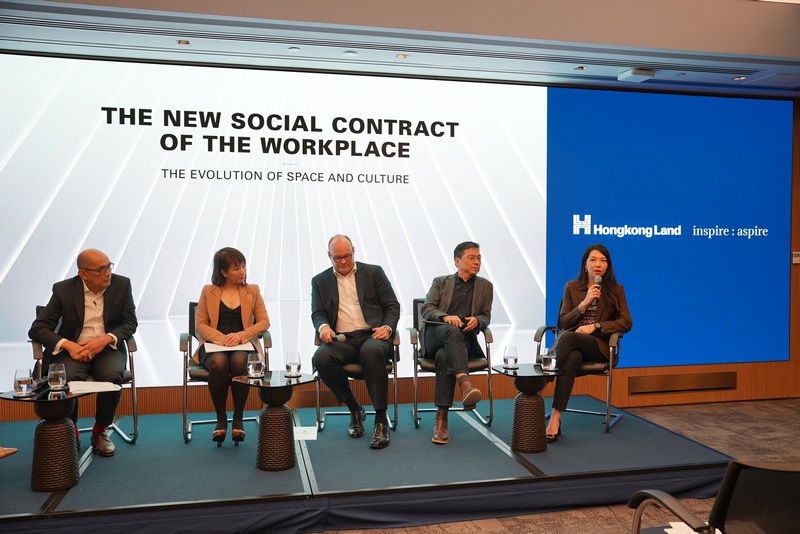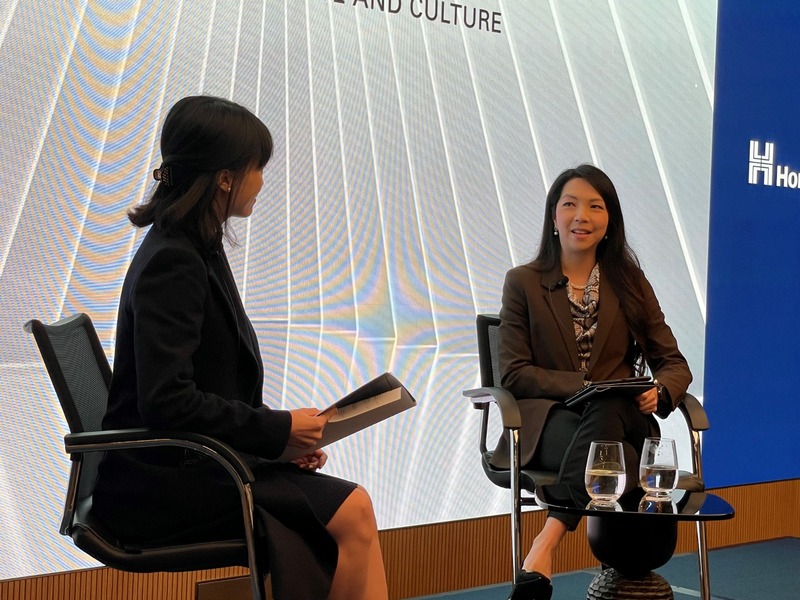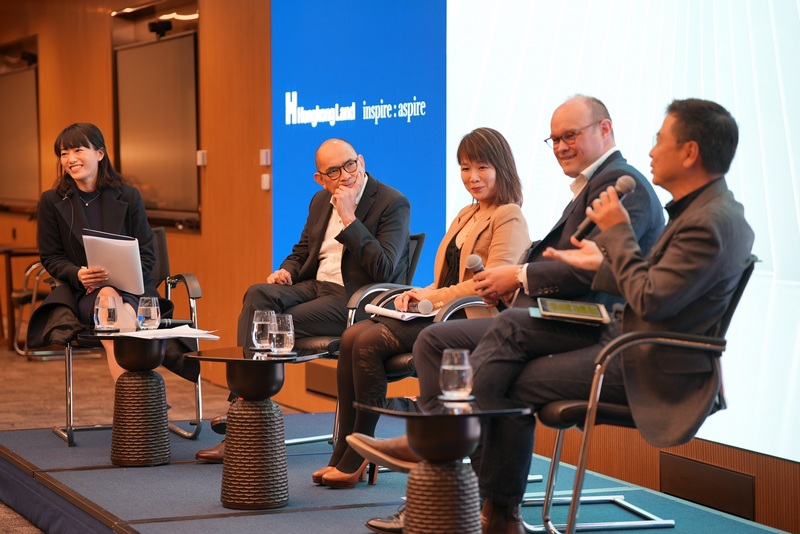(30 March 2023, Hong Kong) Hongkong Land and two of its commercial tenants J.P. Morgan and White & Case, along with Cushman & Wakefield and architectural firm M Moser Associates, shared insights during a panel discussion event on 28 March, which looked at the evolution of the workspace and corporate culture, and its impact on Hong Kong’s office market.
- Flight to quality supporting recovery in Hong Kong office market
Rosanna Tang, Head of Research, Cushman & Wakefield Hong Kong, commented: “Overall, we are seeing an uplift in sentiment and enquiries since the Hong Kong-mainland border fully reopened. For instance, Cushman & Wakefield has been hosting more Chinese visitors from the mainland since February 2023. Yet it will take some time for enquiries to mature into leasing and reflect in the occupancy figures.
“In 2022, the Grade A office market recorded a year with positive net absorption of over 250,000 sq ft – this is the reverse of what we saw in 2020 and 2021 when the market contracted. It’s an interesting indicator of whether firms are downsizing or increasing – people are taking up more space but not less.
“Looking ahead, Hong Kong will continue to benefit from and leverage on its bigger role as the financial centre for the Greater Bay Area (GBA), making it the destination for businesses looking to tap into the GBA market, and also vice versa as a springboard for Mainland firms to connect to the global platform.”
Neil Anderson, Director and Head of Office, Commercial Property, Hongkong Land, commented: “Although it is early days, we have seen encouraging green shoots of recovery in demand from domestic, international and Chinese firms. At Hongkong Land, we have received 46 enquiries in March to date, which is higher than pre-pandemic levels. We are confident that the strength of our ecosystem, innovative products and services, and strong partnerships with tenants, will enable us to continue to perform resiliently and outperform the wider market.”
- Greater emphasis in Hong Kong on role of office in new working norm
The panellists discussed the difference between regions like the US and Asia, where in the US office occupancy stands at 40 percent to 60 percent of pre-Covid levels. While here in Hong Kong, far more people are returning to the office.
Rosanna Tang said: “Our recently published report ‘Obsolescence Equals Opportunity’ shows that, while only 17 percent of workers in the US and 16 percent in the UK prefer to return to the office for three or more days, more than more than 80 percent of workers in China prefer to return to the office for three or more days.”
“Hong Kong is a small city, with relatively short commutes compared to other global cities. In addition, residential apartments are generally small here than in other cities, so Working from Home is not quite feasible for some workers, and they may prefer to go back to the office for higher productivity and face-to-face collaborations with colleagues.
“That said, we are seeing corporates increasingly incorporating flexibility and wellness elements within the workspace post-pandemic. Certainly, some MNCs and banks are adopting a hybrid work arrangement and offering flexibility to employees for better talent retention, especially for the younger generation.”
Neil Anderson added: ”Hong Kong has unique dynamics that underpin the office market, including limited living spaces, short work commutes and exceptional public transport networks. This means that the evolution of the workplace in Hong Kong will differ greatly to other parts of the world.
“The common theme we are hearing from tenants in Hong Kong is that in the new working norm the office has greater importance than ever. Many of our tenants are actively redesigning their spaces to promote greater collaboration and productivity. Our role as a landlord is to support those efforts by providing value-added services that enhance the experience of tenants and their staff.”
- Aligning space with corporate culture
“J.P. Morgan focuses on bringing five pillars to life in its premises – hospitality, sustainability, wellness, flexibility and technology. When these are aligned, we create a workplace that fosters innovation, better products and services to the clients when our people are fully engaged and work in a collaborative space,” said Jun Nepomuceno, Managing Director and Asia Pacific Regional Head, Global Real Estate, J.P. Morgan. “The workplace also focuses on the wellbeing of our employees. Simply put, we believe you can only do first class business in a first class workspace.”
Margie Chan, Partner at White & Case Hong Kong, agreed: “We recently refitted our offices to bring in more light and open space for collaboration. We transformed our reception area, and it looks more like an art gallery now. We have a quiet room for resting and our cafeteria is designed to be elegant and hospitable for colleagues and clients. We now have better space for our internal social events, such as our St Patrick’s Day drinks last Thursday, which is also our anchor day when everyone is in the office together.
“It’s important to us that we create an atmosphere that is professional but also makes it easy to have informal conversations with colleagues, and ensure associates are receiving the advice and mentoring they need.”
Wing Leung, Director, M Moser, agreed. “Companies want to create a strong community. You need to create a place where people feel a strong sense of belonging. Face to face interactions cannot be replaced. Try to mentor on Zoom – you can’t.”
- Workplace wellness no longer a benefit, but an expectation
“We are actually quite proud of the design and planning ideas around our workplace program in our Hong Kong offices, including in Chater House,” said Jun Nepomuceno. “For example, we have installed features that support workplace wellness which have become the norm today in our global offices, such as de-stress areas, system controlled sunshades that optimize natural light, indoor air quality monitoring, height adjustable desks, mothers’ rooms, baristas, multi-purpose space for training facilities and townhalls, as well as game areas. We curated the space with hospitality features like music, aroma and workplace enablers in order to bring the space to life and provide a more personalized experience to our employees.”
“The office is no longer about checking that staff are working, it needs to be designed for mentoring, training and passing on knowledge,” said Wing Leung. “Organisations need to facilitate those activities through space.
“The design of space needs to be a co-creation between designed and end user – when they both own the design and see this as their creation It works. If employees don’t see this as their own design, it won’t be successful.”
- ESG as a service
“As sustainability and DEI become standard to companies’ operations, prospective tenants are increasingly looking to their landlord’s ESG credentials,” said Rosanna Tang. “According to our recent research, in Hong Kong, within the same office submarket, green-certified offices seem to have outperformed those buildings without such credentials. The occupancy difference observed typically ranges between 3% to 5%, whilst the rental difference could range from 5%-25%.”
“Sustainability is certainly key to our choice of location,” said Margie Chan. “ESG is part of the decision process which our own clients use when choosing legal representation.”
“While we are pushing ahead in HK – we are not quite there yet,” said Wing Leung. “It is a very fluid time in terms of ESG. We need to create momentum so people can take small steps? Phase by phase. Bit by bit.”
“We are dedicated to being a leader in sustainability and this aligns with the growing expectations of our tenants to support them in achieving their sustainability agendas,” agreed Neil Anderson. “In fact, at the end of this month, we will complete a six-month environmental impact pilot scheme with 16 of our tenants, where we recognised new tenants’ efforts to reduce their environmental impact as they outfitted their premises, and current and new tenants as they operate in a sustainable manner. Based on the success of the pilot programme, we will soon be launching an ongoing initiative for our tenants to reward their environmental and social sustainability efforts.”
- Importance of workplace ecosystem
“Commercial tenants are looking for more than just a landlord or a set of keys to a modern fitted out set of offices. They are looking for access to a community of like- minded business leaders and decision makers and an array of F&B, retail, cultural and lifestyle options in close proximity that can enrich the experiences of their employees,” concluded Neil Anderson.

Left to Right: Jun Nepomuceno, Managing Director and Asia Pacific Regional Head, Global Real Estate, J.P. Morgan; Margie Chan, Partner, White & Case; Neil Anderson, Director and Head of Office, Commercial Property, Hongkong Land; Wing Leung, Director, M Moser Associates; and Rosanna Tang, Head of Research, Cushman & Wakefield. 
Right to Left: Rosanna Tang, Head of Research, Cushman & Wakefield shares her thoughts on the Hong Kong office markets with Melody Ho, Asset Manager, Hongkong Land (Moderator) in a Fireside Chat. 
Right to Left: Wing Leung, Director, M Moser Associates; Neil Anderson, Director and Head of Office, Commercial Property, Hongkong Land; Margie Chan, Partner, White & Case; and Jun Nepomuceno, Managing Director and Asia Pacific Regional Head, Global Real Estate, J.P. Morgan, discuss the evolution of the workspace and corporate culture in a panel moderated by Melody Ho, Asset Manager, Hongkong Land.












